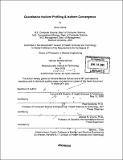| dc.contributor.advisor | Peter Szolovits and George M. Church. | en_US |
| dc.contributor.author | Varma, Chris (Chris K.) | en_US |
| dc.contributor.other | Harvard University--MIT Division of Health Sciences and Technology. | en_US |
| dc.date.accessioned | 2008-02-28T16:14:59Z | |
| dc.date.available | 2008-02-28T16:14:59Z | |
| dc.date.copyright | 2005 | en_US |
| dc.date.issued | 2005 | en_US |
| dc.identifier.uri | http://dspace.mit.edu/handle/1721.1/33732 | en_US |
| dc.identifier.uri | http://hdl.handle.net/1721.1/33732 | |
| dc.description | Thesis (Ph. D.)--Harvard-MIT Division of Health Sciences and Technology, 2005. | en_US |
| dc.description | Includes bibliographical references (leaves 62-65). | en_US |
| dc.description.abstract | Alternative pre-messenger RNA splicing is a crucial step in eukaryotic gene expression, and therefore it is subject to tight regulation. Given its importance in conferring protein diversity, alternative splicing is sensitive to changes in cellular states including malignancy. We present a new paradigm by which to quantitatively study the alternative splicing of any molecule through the presented methods of quantitative exon profiling and quantitative isoform profiling which take advantage of a single-molecule based technology [Mit99]. Furthermore, we extend this paradigm to include a novel unified platform-called Isoform Convergence-to qualify particular isoforms as candidate diagnostic markers, potential therapeutic targets, and perhaps even as precursor therapeutics themselves. We apply this paradigm to quantitatively investigate the alternative splicing of CD44 in two leukemias. CD44 is an alternatively spliced cell surface receptor, which is generally implicated in cancer though the specifics are mired in controversy. In this work, we suggest several corrections to previously made claims about the presence of specific CD44 exons and of specific CD44 isoforms in leukemia as well as in non-diseased cells. | en_US |
| dc.description.abstract | (cont.) Furthermore, we provide not only the first comprehensive characterization of CD44's (or any molecule's) alternative exon splicing in human cells, but also its resulting quantities of exons and isoforms to an average resolution on the order of 1.E+06 molecules. Finally, we identify specific isoforms in each leukemia that may serve as candidate markers or possibly as therapeutic targets. | en_US |
| dc.description.statementofresponsibility | by Chris Varma. | en_US |
| dc.format.extent | 65 leaves | en_US |
| dc.language.iso | eng | en_US |
| dc.publisher | Massachusetts Institute of Technology | en_US |
| dc.rights | M.I.T. theses are protected by copyright. They may be viewed from this source for any purpose, but reproduction or distribution in any format is prohibited without written permission. See provided URL for inquiries about permission. | en_US |
| dc.rights.uri | http://dspace.mit.edu/handle/1721.1/33732 | en_US |
| dc.rights.uri | http://dspace.mit.edu/handle/1721.1/7582 | |
| dc.subject | Harvard University--MIT Division of Health Sciences and Technology. | en_US |
| dc.title | Quantitative isoforrm profiling & isoform convergence | en_US |
| dc.title.alternative | Quantitative isoforrm profiling and isoform convergence | en_US |
| dc.type | Thesis | en_US |
| dc.description.degree | Ph.D. | en_US |
| dc.contributor.department | Harvard University--MIT Division of Health Sciences and Technology | |
| dc.identifier.oclc | 65170446 | en_US |
